
- Name of the Constellations
Eridanus – An astronomical formation found in the southern hemisphere, ranking sixth in terms of size among modern constellations. It stretches from the celestial equator towards the south until it reaches a declination of -58°. Covering a vast area of 1137.9 square degrees in the night sky, it is only surpassed in length by the renowned Hydra. Within this expansive region, there are a total of 187 stars that can be observed without the need for specialized equipment.
The primary celestial bodies of the Eridanus constellation
Ahernar (Alpha Eridanus)
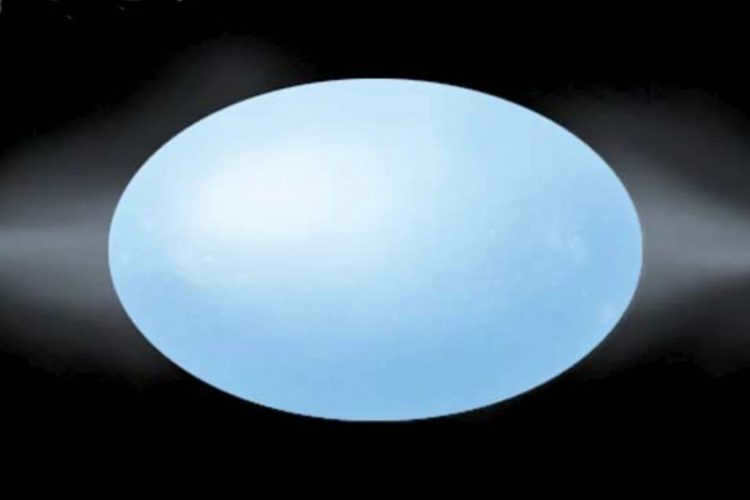
Ahernar, located at the southern end of the “river” in the constellation Eridanus, is the main star of this constellation. While it is not visible to us, it is worth noting some of its unique characteristics. Interestingly, the name Ahernar translates from ancient Arabic as “the end of the river”.
One of the most prominent stars in the Earth’s sky, Ahernar has a brightness of 0.46m, earning it the ninth spot on the list of bright stars. It is a blue star with an average surface temperature of 15000 K, a luminosity 800 times greater than that of the Sun, a mass of 6-8 times that of the Sun, and a diameter 10 times larger than that of the Sun. While it may be located 144 light years away, it is not its distance that makes it remarkable.
Interestingly, Ahernar holds the title for being the most flattened star ever discovered. Its rapid rotation causes its equatorial diameter to be twice the distance between its poles. This unique shape gives Ahernar the appearance of an egg rather than a traditional spherical star. The fast rotation also leads to an uneven distribution of surface temperature, with the poles reaching temperatures of 20000 K while the equator stays at around 10000 K.
Ahernar, the brightest star in the Eridanus constellation, has an intriguing companion. This companion is twice as massive as the Sun and is located at a distance of 12.3 astronomical units from Ahernar. It completes an orbit around Ahernar every 15 years.
The first notable characteristic of the constellation Eridanus is its collection of first magnitude stars. One such star is Alpha Eridanus, also known as Ahernar, which translates to “the end of the river” in ancient Arabic. With an apparent stellar magnitude of 0.46m, Ahernar stands out in the night sky. What sets Ahernar apart is its unique shape, which can be attributed to its unusually high rotation speed. This rapid rotation causes Ahernar’s equator to be half the size of its interpolar distance, resulting in a highly flattened appearance. As a result, Ahernar is considered the most non-spherical star in the field of astronomy.
In addition to being the brightest star in the constellation, Alpha Eridanus also holds a prominent position among all the stars in the sky. Specifically, Ahernar ranks as the ninth brightest star overall. Alpha Eridanus is a blue supergiant located 144 light-years away from Earth. It is situated at the rear of the Eridanus constellation, giving it its Arabic name.
Ahernar belongs to the B3 V spectral class and has a surface temperature of 15,000 K. Its luminosity is about 800 times greater than that of the Sun, and it has a mass approximately 6-8 times that of the Sun. Its radius is 10 times larger than the Sun’s. Alpha Eridanus is situated on the main sequence of stellar evolution.
Cursa (Beta Eridanus).
Cursa (Beta Eridanus) is an enormous star (AZ III) that stands out with its brightness, having an apparent magnitude of 2.796, making it the second brightest star in its constellation. It is located 89 light-years away and can be observed near the border with Orion. Cursa also has a visual companion, which is 120 arc seconds away and has an apparent magnitude of 10.90. This star exhibits a rapid rotational velocity of 196 km/s. Interestingly, Cursa is a variable star, with its visual magnitude ranging from 2.72 to 2.80. The name Cursa originates from the Arabic term “Al Kursiyuu al Jauzah,” which translates to “the bench.” Additionally, Cursa is part of a star association that includes Lambda Eridanus, Psi Eridanus, and Tau Orion, all of which can also be observed in the Orion constellation.
Cursa is located at a distance of 89 light-years from Earth and emits a gentle white light from its surface, which has a temperature of 8,360 K. This celestial body is classified as a giant star of spectral class A3 and has a diameter approximately three times larger than that of the Sun. Its luminosity is 45 times greater than that of our Sun, and its mass ranges from 2 to 2.5 times the mass of the Sun.
Coors is commonly considered to be a member of the moving group associated with the Big Dipper, a constellation consisting of several stars scattered across the sky, including the five stars that form the recognizable shape of the Big Dipper. However, given that this group is estimated to be around 300 million years old, it is too young to include Cursa as a member. Instead, it is more likely that Cursa belongs to the Sirius supergroup.
In addition, Cursa represents a highly uncommon category of stars that generate massive bursts. Back in 1985, a remarkable surge in brightness was recorded, with the stellar magnitudes increasing by three (equivalent to a factor of 15), a phenomenon that persisted for over two hours. This class of stars, including Enif (epsilon of Pegasus) and Mu Cepheus, is comprised of just about two dozen celestial bodies. The exact cause behind these bursts remains a mystery. Drawing from our understanding of solar flares, it is plausible that they stem from the star’s magnetic activity; however, it is also conceivable that there exist alternative mechanisms responsible for augmenting luminosity.
Akamar (Theta Eridana).
Akamar (Theta Eridana) is a binary star that might be a part of a multiple star system. The primary component is classified as A4 and has a visual magnitude of Z.2. The secondary star is an A1 class star with an apparent magnitude of 4.Z. They are separated by an angular distance of 8.Z seconds. The combined apparent visual magnitude is Z.2 and the star is located at a distance of 161 light-years. The name “Akamar” is derived from the Arabic word Ākhir an-nahr, which translates to “end of the river”. This star was historically considered as the end point of the celestial river Eridanus. However, the role of marking the end of the river is now attributed to the star Ahernar. Both names have a common origin. Since Ahernar was not observed by the ancient Greeks, Hipparchus and Ptolemy chose Akamar to represent the end of the river.
Zaurak (Gamma Eridanus).
Zaurak (Gamma Eridanus) is a star classified as M1IIIb with a visual magnitude of 2.95. It is situated approximately 150 light-years away from our solar system. The etymology of its name can be traced back to the Arabic word for “boat.”
Rana (Eridanus Delta)
Rana (Delta Eridanus) is a subgiant star categorized as K0 IV, having a visual magnitude of Z.54. Its distance from our solar system is estimated to be 29.49 light-years. Interestingly, the word “Rana” originates from Latin and refers to a “frog.”
Tau-4 Eridana (Τ4 Eridana)
Tau-4 Eridana (Τ4 Eridana) is a binary star system (MZ.5III) with a visual brightness of Z.70 and situated approximately 258 light-years away. The primary component of this system is a giant star of M-class, which has a visual magnitude of Z.66.
Epsilon Eridana (Ε Eridana)
E Eridana (Epsilon Eridana) is a K2V main-sequence star with a visual magnitude of Z.7Z6 and a distance of 10,489 light-years. It has a mass that is only 82% of the Sun’s mass and a radius that is 74% of the Sun’s radius. This star is the ninth closest star to the Sun and is the third closest individual star or star system that can be seen without binoculars. E Eridana was previously the closest star known to have a confirmed planet in its orbit until Alpha Centauri Bb was discovered. Its age is estimated to be around 440 million years old, ranging between 200 and 800 million years. Surrounding this star is a large outer disk of debris. Due to light pollution, it can be very challenging to observe E Eridana with binoculars from within heavily populated areas. This star is classified as a BY Dragon variable.
Because the star is in such close proximity to the Sun, SETI (Search for Extraterrestrial Intelligence) closely monitors it, and it is frequently depicted in science fiction literature. In the year 2000, scientists observed a massive planet, known as Epsilon Eridanus b, orbiting this star with a seven-year cycle.
This particular star has piqued the interest of astronomers due to its intriguing characteristics. Epsilon Eridana is the third furthest star from our nearest neighboring stars, located just 10.5 light years away.
Epsilon Eridanus possesses a luminosity of 3.73m and is classified as a main-sequence star, sharing many fundamental characteristics with our Sun. This star exhibits a marginally smaller mass, approximately 85% of the solar mass, and a radius that amounts to 84% of the solar radius. Nevertheless, Epsilon Eridanus is relatively youthful, with an estimated age of around 500 million years. Consequently, the likelihood of hosting highly developed life forms on its planets is rather low. Nevertheless, this stellar system is known to possess planets, a circumstellar dust disk, and two asteroid belts.
In 200, a massive planet with half the mass of Jupiter was found orbiting a star at a distance of 3.3 a.u. This planet was initially named Epsilon Eridanus B, but in 2015 it was renamed Aegir. The Hubble telescope provided valuable information about Aegir, revealing that its mass is now estimated to be 1.55 times that of Jupiter and its orbital period around the star is approximately 2500 days.
An artist’s depiction of the Epsilon Eridanus system.
Based on the analysis of irregularities in the dust disk and other phenomena within this stellar system, scientists hypothesize the existence of another planet. This hypothetical planet, Epsilon Eridanus C, is predicted to have a mass roughly 0.1 times that of Jupiter and orbit at a distance of 40 a.u. However, Epsilon Eridanus C has not yet been observed.
Epsilon, a star in the Eridanus constellation, is fascinating because it is surrounded by not just one, but two asteroid belts. Both of these belts were discovered by American astronomers in 2008. The first belt is located at a distance of 3 astronomical units from the star, while the second belt is situated 20 units away. Additionally, it is believed that there is at least one exoplanet orbiting Epsilon, which has been named Epsilon Eridanus b. This planet bears similarities to Jupiter and has an elongated orbit around the star, being 3.3 astronomical units away from it.
Cade (40 Eridanus)
Cade (40 Eridanus, Omicron-2 Eridanus) is a three-star system. The traditional name “Cade” originates from the Arabic word “qud” which means “(egg) shell”. 40 Eridanus A is a main-sequence dwarf (K1) with a visible brightness of 4.4Z (it can be observed even without binoculars). The pair 40 Eridanus b and 40 Eridanus C consist of a white dwarf (DA4) and a red dwarf (M4.5e) with visual magnitudes of 9.52 and 11.17, respectively. These stars were discovered by William Herschel on January 1, 178Z. The second object in the pair is a flaring star known as DY Eridanus. If you are a Star Trek enthusiast, you may recall the planet Vulcan. It was initially depicted in the orbit of the star Alnitak in the constellation Orion, but in the Star Trek II script, author James Blish relocated the planet to the orbit of 40 Eridanus A. It is also referred to as Omikron 2.
The star known as Omicron 2 is situated 16.45 light years away from our planet, making it relatively nearby. However, it is not just an ordinary star, but rather a triple system comprised of three dwarf stars.
One of the components, named Keid, is a red dwarf and happens to be the brightest star within the system. It is believed to have a planet that is eight times more massive than Earth.
Located 400 astronomical units away from the main component A are a pair of other dwarf stars. Component B is a white dwarf, smaller in size than Earth and similar to the white dwarf found in the Sirius system. It shares a common center of mass with component C, a red dwarf that is three times smaller than the Sun. This double system has an orbital period of 252 years, and at the same time, it orbits component A with a period of approximately 8 thousand years.
It is a rather unique arrangement – with multiple, and potentially even planetary, bodies. This particular star has been featured numerous times in works of science fiction literature. Notably, the fictional planet Vulcan from the Star Trek series is said to be located in this system.
When observed through a telescope, 40 Eridana appears as a binary star system – the A component can be seen with the naked eye, while the B component has a magnitude of 9.5m.
40 Eridana A
The first component of the Omicron 2 system is the star 40 Eridana A, which is also the brightest among all the components. This particular celestial body is classified as an orange dwarf star of spectral class K1V. It is visible to the naked eye and does not require the use of optical instruments. The star is approximately 6.5 billion years old and possesses a metallicity that is 35% lower than that of the Sun.+
The star 40 Eridana B was originally considered a single system until 1851, when scientist Struve discovered that it actually consists of two separate components. In 1910, the star 40 Eridanus B was identified and classified as a type of white dwarf with a stellar magnitude of approximately 9.5m. Despite its high surface temperature of around 17000 K, the star has a relatively weak luminosity.
On the other hand, the star 40 Eridana C is a red dwarf with a spectral class of M4.5eV. It is known for its flaring behavior and is often mentioned in various works of fiction.
82 Eridana (HD 20794).
82 Eridana (HD 20794) is a star in the main sequence (G8V) category. It has a visual magnitude of 4.254 and is located at a distance of 19.71 light-years. While it is smaller and less massive than the Sun, it is much older, with an estimated age of 6-12 billion years. It is also known for its high-speed travel. On August 17, 2011, a discovery was made of multiple planets in its orbit, which are larger than Earth in terms of mass and classified as super-Earths.
Eridanus EF
EF Eridanus is classified as an AM Hercules or polar variable, which is a specific type of cataclysmic binary variable known for its exceptionally powerful magnetic field. This system is situated approximately Z00 light years away from Earth. The overall brightness of the system can vary, with visual magnitudes ranging from 14.5 to 17.Z. Within this binary system, there is a white dwarf and a former star with a substellar mass that orbits around the white dwarf. The substellar mass was originally a star that transferred gas to the white dwarf, but it has since transformed into a ball with a mass equivalent to 0.05 times that of our Sun.
Exciting things to observe
Aside from captivating stars, this constellation also boasts captivating deep space objects.
1. NGC 1084 Spiral Galaxy
NGC 1084 is a spiral galaxy classified as Sc type. It has a visible magnitude of 10.7m and measures 2.8′ × 1.4′ in size.
This galaxy is remarkable because in 2009, amateur astronomers detected a “new” bright spot within it. It turned out to be a supernova flash that was even visible in telescopes on the Earth’s surface.
When observing through telescopes with a main mirror diameter of up to 150 millimeters, it can be difficult to distinguish the spirals of the galaxy. However, the central part of the galaxy appears brighter and has an oval shape. The galaxy is located near the border of the constellation Kit, and it is recommended to begin the search from the star η Eri, which has a brilliance of 3.85m. Residents of Belarus, Ukraine, and most of Russia have the opportunity to observe the NGC 1084 galaxy during the last months of the year.
2. NGC 1232: An Unconventional Spiral Galaxy
NGC 1232, classified as an SBc type spiral galaxy, is not your typical spiral galaxy. It falls into the category of peculiar or irregular galaxies as well. This unique specimen was first observed by the renowned English astronomer William Herschel in late 1784. Interestingly, in the image provided, there is another galaxy situated alongside NGC 1232. It is possible that due to gravitational interactions between these galaxies, NGC 1232 was initially misidentified and labeled as a peculiar galaxy.
NGC 1232 boasts a brightness magnitude of 9.8m and has an apparent size of 7.4′ × 6.5′. It is positioned in such a way that it appears to be “facing” us. With the aid of a powerful telescope, one can examine this galaxy in great detail and discern its spiral structure. The central region, or core, exhibits an elongated oval shape. Additionally, a nearby star shines with a luminosity of 9.15m.
3. NGC 1300: The Fascinating Spiral Galaxy
NGC 1300, a captivating spiral galaxy featuring a unique junction, boasts an apparent size of 6.2′ × 4.1′ and a luminosity of 10.3m.
One intriguing aspect of NGC 1300 is the absence of an active nucleus at its center, indicating the absence of a supermassive black hole.
These types of galaxies are ideal for observation using amateur telescopes. The spirals exhibit pronounced curvature and significant gaps between them. Rather than perceiving a mere “dust cloud” or hazy spot, Earth-based observers can discern brightness variations, contrasting features, and a vibrant center within the galaxy. With a powerful telescope (300 millimeters or more), it becomes possible to distinguish the peripheral regions of the galaxy.
NGC 1300 is located in close proximity to NGC 1232 and is typically observed in conjunction with it. Just to be sure, I have also indicated the direction to the desired galaxy with a green arrow on the provided map.
4. NGC 1407: An Elliptical Galaxy
NGC 1407, an extremely large elliptical galaxy, serves as the central hub for a cluster of over 250 galaxies. Personally, I find these numbers mind-boggling. It’s nearly impossible to fathom the sheer magnitude of this entire metropolis. In the image above, it becomes difficult to distinguish between stars and galaxies.
Most of the galaxies in the cluster have brightness levels lower than the 14th magnitude and are not accessible to amateur telescopes. However, the central galaxy has a visible stellar magnitude of 9.7m and has dimensions of 4.6′ × 4.3′. When observed through a telescope, it appears as a very bright, round spot. Through a wide-angle eyepiece, two galaxies (NGC 1407 and NGC 1400) can be observed simultaneously.
It is still worth starting the search for a pair of galaxies from the bright star τ4 Eri and moving in a clockwise direction. The previous atlas displayed this path using red arrows.
5. NGC 1400: An Elliptical Galaxy
NGC 1400, an elliptical galaxy, is relatively faint with a magnitude of 10.9. Despite its small size, it can be observed using semi-professional telescopes. This galaxy is nestled among over 200 other galaxies and can be spotted in the lower right corner of the previous image. Elliptical galaxies, in general, do not offer much observational interest. They typically possess a uniform round shape, with a bright central region and a heavily blurred outer region. Consequently, it is impossible to discern any intricate details within these galaxies.
6. NGC 1187: A Fascinating Spiral Galaxy
NGC 1187, a mesmerizing spiral galaxy, seems to have mysteriously disappeared from the Stellarium planetarium map. This galaxy shines with a brightness of 10.6m and boasts dimensions of 4.2′ × 3.2′. It presents itself to Earth observers at almost a “face-on” angle, revealing its slightly flattened shape and elongated central region.
Fortunately, locating NGC 1187 in a telescope is a breeze: simply look 40′ north of the prominent star τ3 Eri.
7. NGC 1535: A Stunning Planetary Nebula
NGC 1535, a planetary nebula, is a captivating sight for observers, although it does require advanced techniques and ample practical experience to observe. Astrophotographers are more likely to pursue this celestial object than amateur visual observers. With a brightness of 9.6m, NGC 1535 is relatively dim, and its size is quite small, measuring only 56″ × 52″. This makes it five times smaller than the well-known planetary Ring Nebula (M 57) in the Lyra constellation. The breathtaking image displayed above was captured by the Hubble telescope. Notably, there is a 17th magnitude star located at the center of the nebula.
Interestingly, in certain astronomy programs, such as the planetarium Stellarium, this nebula is referred to as “Cleopatra’s Eye”.
NGC 1535 can be observed by people living in northern latitudes from November to December. A helpful tip is to look for a very bright and large star in the nearby constellation Orion – Rigel. To be more precise, you can begin your search from the variable double star Zaurak (γ Eri).
8. NGC 1637: A Spiral Galaxy with a Unique Bar Structure
NGC 1637 stands out among spiral galaxies due to its distinct bar-shaped feature. With a magnitude of 10.9m and dimensions of 3.3′ × 2.7′, this galaxy captures the attention of astronomers. One notable characteristic of NGC 1637 is the asymmetry of its spiral arms. Scientists believe that this galaxy is relatively young and its final image is still in the process of formation. It is fascinating to consider how NGC 1637 might evolve and transform in the distant future.
Interestingly, the Stellarium program does not include NGC 1637 and the neighboring galaxy NGC 1600, despite their presence in the catalog. However, if you search for their specific names in the program, it will accurately center on these objects.
NGC 1637 can be found in the northern region of the Eridanus constellation, positioned between two prominent 4th magnitude stars, μ and ν Eri.
9. NGC 1600: An Unremarkable Elliptical Galaxy
Nestled among the countless background stars, the unassuming elliptical galaxy NGC 1600 may easily go unnoticed. However, this celestial object is certainly worth observing through an amateur 150-millimeter telescope. While lacking in noticeable details or peculiarities, NGC 1600 boasts an elegant oval shape that is elongated vertically. With a brightness of 11m and a size of 2.5′ × 1.7′, this unremarkable galaxy still holds its own in the vast expanse of the universe. To locate NGC 1600, simply follow the green arrow in the map above.
10. NGC 1909: The Witch’s Head Reflection Nebula
NGC 1909, also known as the Witch’s Head, is a fascinating cloud of gas and dust that forms a reflection nebula. It earned its nickname due to its uncanny resemblance to a witch’s head. Deep within this gas cloud, there is an active process of star formation taking place. The nebula’s bluish hue is a result of the scattering of light, with blue light scattering more easily than other colors.
Despite having a brightness of 8m, the Witch’s Head nebula is incredibly challenging to observe visually through a telescope. Even with the use of a narrow-band light filter, it remains almost impossible to see. However, this celestial object is of great interest to astrophotographers. They strive to capture the vast expanse of the nebula, which measures a size of 180.0′ × 60.0′, along with the dazzling Rigel star in a single field of view. The resulting spectacle is truly breathtaking!
However, it won’t be a challenging task to locate the nebula. First, locate the constellation Orion, then find the star Rigel and rotate the telescope tube in a clockwise direction:
11. NGC 1532 Spiral Galaxy
NGC 1532 is an incredibly stunning and notable spiral galaxy with a junction. It possesses an impressive size of 11.6′ × 3.4′ and a brightness of 9.8m (some sources suggest a value of 10.6m).
The image actually represents a pair of interacting galaxies. The smaller one is NGC 1531, which has a brightness not exceeding the 13th stellar magnitude. Eventually, the larger component will completely absorb its neighbor and transform into a single galaxy of a larger size.
One of the excellent and more detailed images is provided below (click to open in full size in a new tab). The process of galaxy merging has already commenced.
Galaxies in Belarus can only be seen for a few weeks each year in November, when they are very low on the horizon. Due to the bright lights and their proximity to the horizon, people often overlook these celestial objects. However, you and I will make a note of their location on the map and make sure to observe them through a telescope and document our findings.
12. NGC 1269: An Unusual Spiral Galaxy
NGC 1269, located in the constellation Eridanus, is the twelfth and final deep-sky object in this constellation. What makes this spiral galaxy unique is its peculiar shape, with its spirals forming a ring around the nucleus. With an apparent stellar magnitude of 8.5m and a size of 11.0′ × 9.5′, NGC 1269 is a captivating sight.
This extraordinary galaxy can only be observed by those residing in the southern latitudes.
The Relict Cold Spot or Eridanus Super Void
Furthermore, Eridanus possesses a distinct feature in the form of a super void or void located in close proximity. This zone is characterized by the absence of galaxies, making it one of the most extensive voids ever discovered in the realm of space exploration. The diameter of the cross-section of this void surpasses a billion light years.
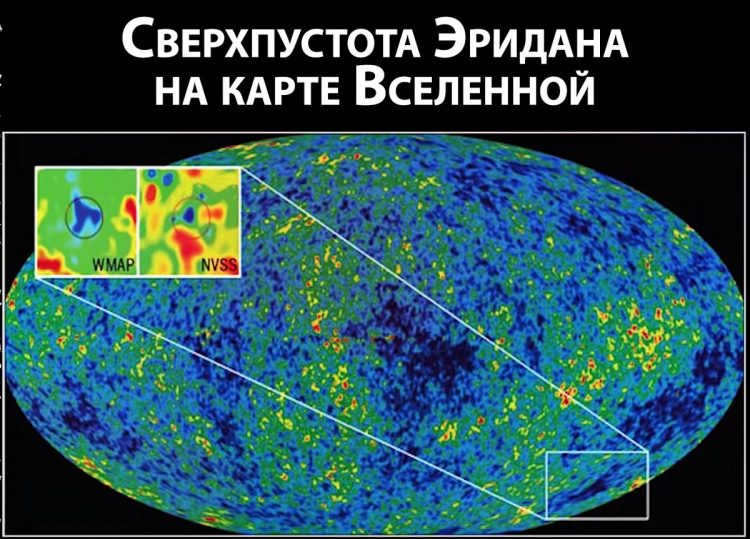
Thanks to this celestial object, several hypotheses have been proposed regarding the genesis of substance and the cosmos.
Locating the star formation in the celestial sphere
Eridanus can be found in the Southern Hemisphere and is surrounded by a large number of constellations. There are various well-known constellations in close proximity to Eridanus, including Taurus, Oven, Clock, Whale, Hare, Orion, Phoenix, as well as the Chisel and the Southern Serpent. To locate the constellation Eridanus, the easiest method is to use the prominent figure of Orion as a guide. Eridanus is situated nearby, to the right and below Orion. This particular constellation is most commonly observed during the winter season when it is at its highest point above the horizon. However, in regions such as Russia, only a portion of the constellation can be seen due to its southern location.
Origin and Background of the Eridanus Constellation
The Eridanus constellation holds a rich history, dating back to ancient times. While the true founder remains unknown, the first recorded account of this celestial object can be attributed to the ancient Greek philosopher Eudoxus, who documented it in the fifth century BC. Its official name, Eridanus, was mentioned for the first time in the Almagest, a comprehensive catalog of the celestial sphere compiled by the esteemed astronomer Claudius Ptolemy in the first century AD.
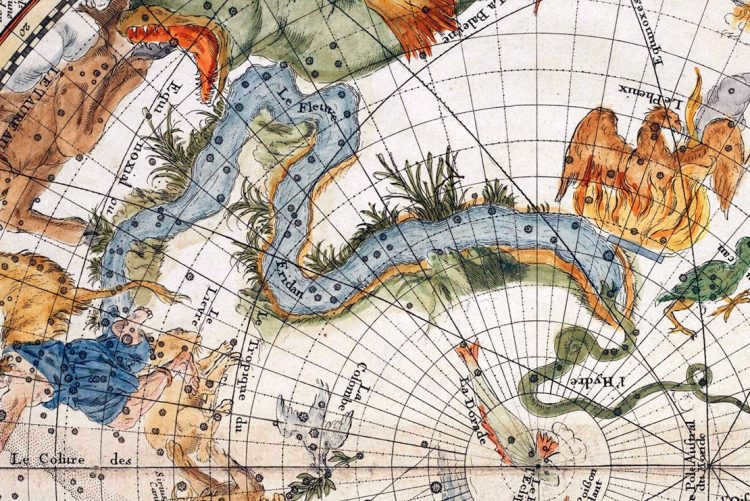
The legend of the star constellation
In the ancient Greek legends, the star constellation was linked to Phaeton, the son of the sun god Helios. In the ancient Greek texts, the Eridanus River was identified as either the Nile, Po, or Euphrates rivers. The story of Phaeton tells of his ill-fated ride in his father’s celestial chariot, which he failed to control. As the chariot neared the Earth, a massive fire erupted. In order to prevent further disaster, the god Zeus struck Phaeton with a bolt of lightning, causing him to plummet into the river.
According to one version of the myth, Phaeton met his demise in the river Eridanus after being struck by the thunderbolt. After his death, the son of Helios transformed into a star in the sky. The constellation itself represents the river that served as his final sanctuary.
According to a different myth, Phaethon, after losing control of his chariot, left an unmistakable meandering path in the heavens. This is what formed the constellation Eridanus.
In ancient Greek mythology, the constellation Eridanus was closely associated with Phaethon. Phaethon was the son of Helios and Clymena, and from a young age, he had a burning desire to embark on a new journey across the sky using his father’s chariot. However, Helios insisted that he stick to the already established path. The tracks left by the chariot’s wheels were still faintly visible along the route.
Phaethon defied authority and veered the chariot towards the heavens. Initially, it appeared to him that everything was proceeding “according to plan”. However, soon he lost control. The chariot plummeted to the ground and skimmed so closely to the surface that it could have ignited itself. It is speculated that this is how the Libyan desert came to be, with all the seas drying up.
Zeus, furious with the rebellious young man, struck him with lightning and subsequently banished him to Eridanus. Helios was so devastated by this turn of events that he decided to keep the chariot grounded for several days. During this time, the Earth was plunged into darkness. The current constellation name was bestowed by Aratus, an ancient poet. In contrast, Ptolemy named the celestial body Potamos, which translates to “river”.
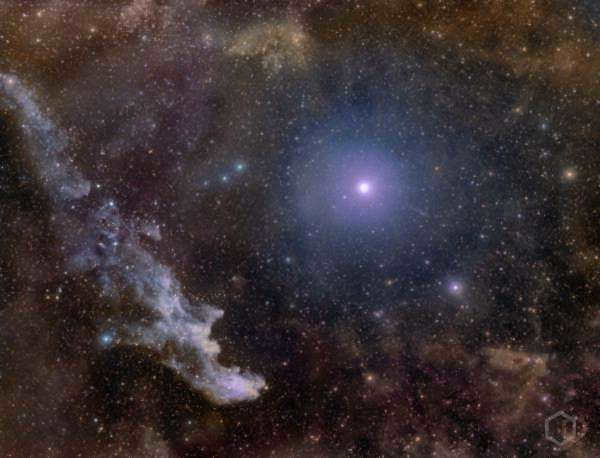
The constellation Orion is widely recognized as one of the most stunning sights in the nighttime sky. It has captured the imagination of countless individuals, including many from their earliest years. It is a celestial arrangement that is simply impossible to overlook, as its prominent stars and stellar objects can be seen directly from Earth without the aid of any special equipment. Among these captivating elements are luminaries that far outshine our own Sun in various ways, as well as the awe-inspiring M42 Large Nebula. The duo of brilliant stars within the Orion constellation, namely Rigel and Betelgeuse, are particularly easy to locate in the vast expanse of the sky. Their presence serves as a helpful guide for identifying the other components of this remarkable constellation.
Description
The text needs to be paraphrased while maintaining its unique quality and HTML markup.
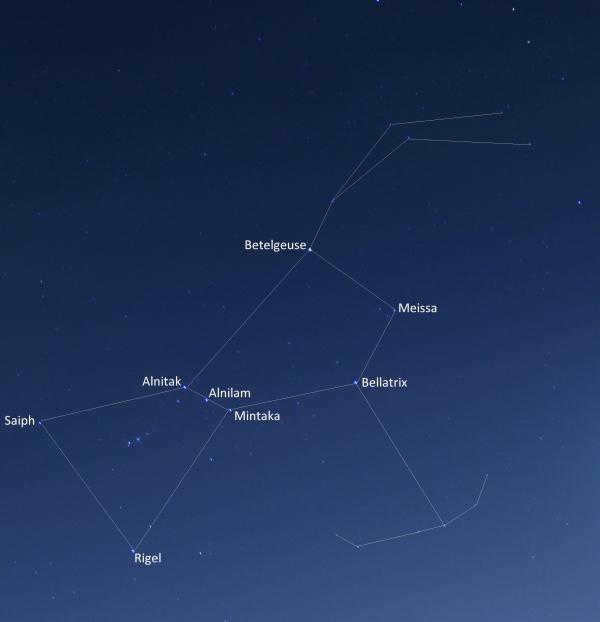
The constellation Orion is steeped in ancient mythology. According to legend, Orion was a skilled hunter and the beloved companion of Artemis. However, his life was tragically cut short due to the jealousy of his brother Apollo. In her grief, Artemis immortalized Orion by placing him in the night sky, where he remains as a reminder of their love.
It is quite simple to recognize the outline of the hunter in the arrangement of celestial bodies. He appears suspended in the sky, wielding a raised club, sporting a sword on his belt, and holding a shield in his hand. The various components of the constellation depict well-known asterisms. The cluster of stars forms a distinct figure. Orion’s belt is comprised of three highly visible stars arranged in a straight line. Just below is the Sword of Orion asterism, which includes two stars and a hazy patch of nebula M42 nestled between them. The belt points towards Sirius at the southeastern end of the line and Aldebaran at the northwestern end.
Each bright star within the Orion constellation is truly remarkable. The surrounding constellations pale in comparison, as they lack the same abundance of luminous elements.
The Reigning Champion of the Celestial Realm
Amidst the breathtaking beauty of the night sky, there are two celestial behemoths that truly steal the show. Known by their historical names, Rigel and Betelgeuse, these stars shine brightly in the constellation Orion. Scientifically referred to as Beta and Alpha of Orion respectively, both giants are easily visible from Earth. It could be said that they are in a fierce competition for the esteemed title of being the premier star in this celestial pattern. While Betelgeuse is officially labeled as Alpha, Rigel outshines it ever so slightly.
Originating from Arabic, the names of these two brilliant stars hold significant meaning. Rigel translates to “foot,” perfectly describing its position in relation to Orion. On the other hand, Betelgeuse means “armpit,” accurately depicting its placement on the hunter’s body. Orion’s Alpha proudly resides on the right armpit, while Beta takes its place on the leg.
Scarlet supergiant

According to various criteria, Betelgeuse can be considered the most important star in the Orion constellation. It is a red supergiant that falls into the category of semi-regular variable stars, meaning its brightness can vary from 0.2 to 1.2 magnitudes. In comparison, the Sun has a much lower luminosity, exceeding Betelgeuse’s lower limit by eighty thousand times. The star is estimated to be located around 570 light years away from Earth, although the exact distance is still unknown.
The magnitude of Betelgeuse can be comprehended by contrasting it with the magnitude of the orbits of the planets in the solar system. If we were to substitute our Sun with Betelgeuse, the smallest dimension of the star would encompass the entire expanse up to the orbit of Mars, while the largest dimension would align with the orbit of Jupiter. Betelgeuse’s mass is 13 to 17 times more substantial than that of the Sun.
Challenges in Research
Measuring the precise diameter of Alpha Orion poses a challenge due to its unique characteristics. As the star moves away from its center, its brightness gradually diminishes, making it harder to obtain an accurate measurement. Scientists estimate that if we consider the distance to Betelgeuse as 650 light years, the diameter of Alpha Orion can range from 500 to 800 times that of our own sun.
Betelgeuse, the initial celestial body following the Sun, has been successfully imaged by a space telescope, capturing its disk and revealing its ultraviolet atmosphere with a prominent central spot. This spot is considerably larger than the Earth’s diameter and exhibits a significantly higher temperature compared to the rest of the star’s surface. The origin of this remarkable feature remains unknown, leading to speculations that it could be the outcome of a novel physical phenomenon impacting the star’s atmosphere.
Orion’s limb

Rigel, the brightest star in the constellation Orion, is often used as a reference point in the sky. Its neighboring constellations, Hare and Eridanus, can be easily identified due to their close proximity to Rigel. Furthermore, Rigel is a blue-white supergiant with a visual stellar magnitude of 0.12 and is located approximately 860 light-years away from the Sun. While its radius is smaller than that of Betelgeuse, Rigel has a luminosity that is 130 thousand times greater than our own star. In terms of luminosity, it even surpasses Alpha Orion.
Rigel, similar to Betelgeuse, is a star that exhibits variability in its brightness. It undergoes an irregular cycle where its magnitude fluctuates between 0.3 and 0.03 over a period of approximately 24 days. Rigel is commonly known as a triple star system, but there are claims that it may actually have a fourth component. However, conclusive proof of this additional component has not been acquired.
Neighbour

The nebula located near Orion’s Beta is known as the Witch’s Head. Its appearance bears a striking resemblance to the head of a witch wearing a pointed hat. This particular nebula is classified as a reflection nebula, meaning it emits light due to its proximity to the star Rigel. When captured in images, the Witch’s Head nebula exhibits a bluish hue, as the dust particles within the nebula reflect blue light more prominently. Additionally, Rigel itself primarily emits light in the blue part of the spectrum.
Evolution
The constellation Orion is home to two dazzling stars that will not maintain their brilliance forever. Eventually, the internal processes of both stars will lead to the depletion of their fuel and potentially result in a spectacular explosion. Despite their impressive size, their existence is not long-lasting. However, for our century, their radiance will certainly endure. Betelgeuse is projected to continue shining for at least another two thousand years before it undergoes a collapse and explosion. During this event, its brightness will be comparable to half or even the full Moon. Alternatively, Betelgeuse may transform into a white dwarf in a more subdued manner. Regardless of the outcome, the shoulder of Orion will fade from the perspective of observers on Earth at the conclusion of this process.
Rigel, too, awaits a fate of brief luminosity in the sky, culminating in a tremendously powerful explosion. According to assumptions, its fury will be on par with a quarter of the Moon.
Other notable figures
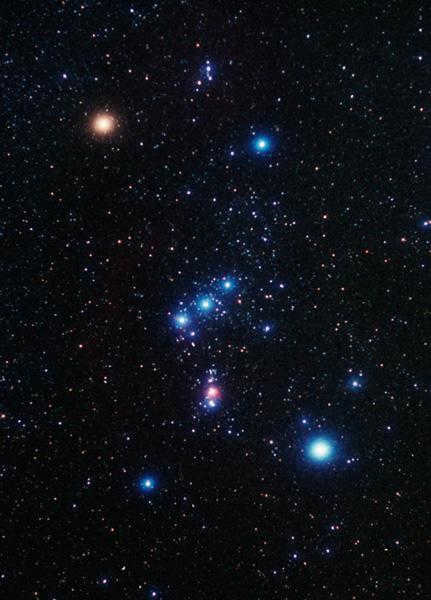
In the constellation Orion, there are not only two bright stars that are highly visible. This pattern in the sky also consists of three luminaries that make up the hunter’s belt. These three stars, known as Mintaka (Delta Orionis), Alnitak (Zeta Orionis), and Alnilam (Epsilon Orionis), are easily visible from Earth. On the left shoulder of the hunter is Bellatrix (Gamma Orionis), which is the third brightest star in the constellation. Bellatrix shines with a luminosity that is 4,000 times greater than that of the Sun. One notable characteristic of Bellatrix is its significant surface heating, with an estimated temperature of 21,500 degrees Kelvin.
Nebulae and black hole
Located just below the Belt in the constellation Orion, there are two other prominent stars that are part of the Sword of the Hunter. These stars, known as Theta and Iota of Orion, share the same region. Positioned between them, there is a third object that is often mistakenly classified as a star. However, this object is none other than the Great Orion Nebula, which appears as a small, hazy spot from our planet. Within this nebula, new stars are constantly being formed, making it a hub of stellar activity. Interestingly, it is also believed to harbor the closest black hole to Earth, which boasts a mass 100 times that of the Sun.
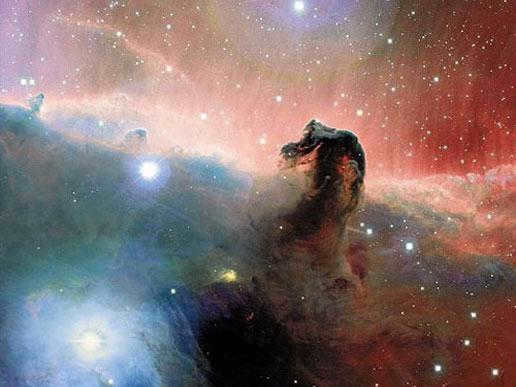
Equally well-known as M42 are the Torch and Horsehead nebulae, which are also situated in the Orion constellation. The former bears a striking resemblance to flames flickering above a roaring fire, hence its given name. The Horsehead Nebula, on the other hand, aptly justifies its title with its distinctive shape. The silhouette of a horse can clearly be discerned in the imagery, as though it is ready to gallop away. Serving as a reflection nebula, the Horsehead does not emit its own light. The background nebula IC 434 provides the opportunity to marvel at this celestial spectacle, as it illuminates its dusky counterpart.
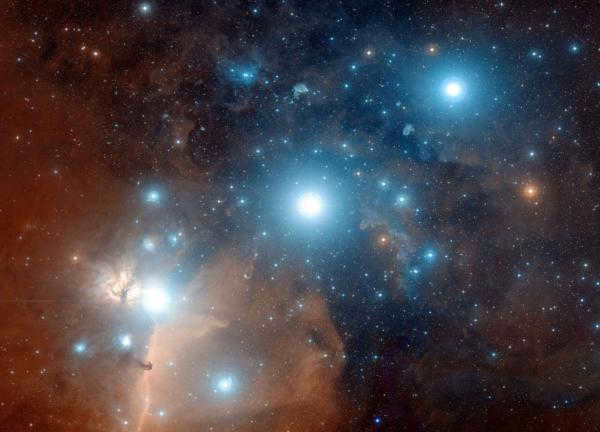
The constellation Orion often appears in many telescope images. The photos showcase fascinating objects such as stars, nebulae, and clouds of gas and cosmic dust, all of which are incredibly beautiful. However, when viewed from Earth, the silhouette of the hunter is equally impressive. It is rare to find such a multitude of bright and easily observable objects with the naked eye in any other celestial images.
For those interested in exploring the hidden beauty of the mythical hunter, there are numerous astronomy resources available. Websites like “Astrogalactica”, the Google Sky star map, and the Google Earth service provide opportunities to study the constellation Orion.
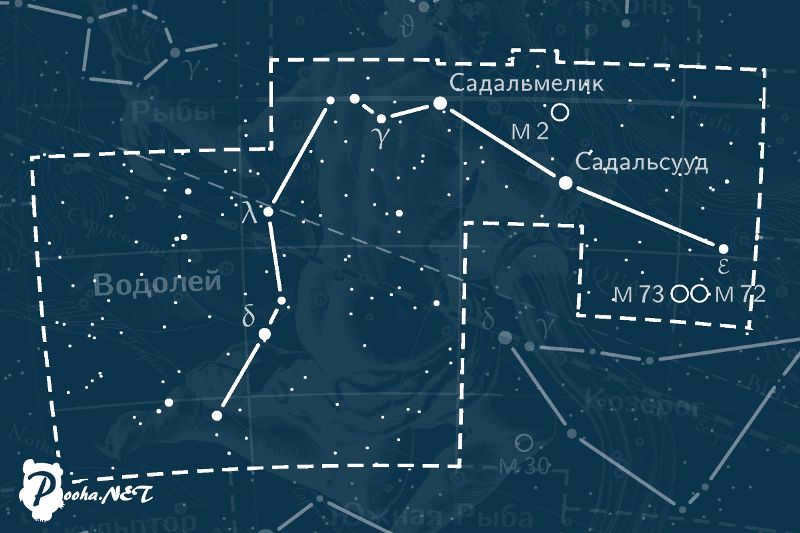
- Area: 979.854 sq. yd.
- Occupies of the total area: 2.38 %
- Abbreviation: AQR
The constellation known as Aquarius is situated between Capricorn and Pisces. Typically, the Sun is found in this constellation from February 16 to March 11. However, it is important to note that the constellation of Aquarius should not be confused with the zodiac sign of the same name, in which the Sun is believed to be present in Western astrology from approximately January 21 to February 19.
Aquarius held great significance among the ancient Sumerians as it symbolized the god Ana, who bestowed life-giving water upon the earth. The Greeks associated Aquarius with various mythical figures, including Ganymede, the Trojan youth who became the cupbearer of Olympus, Deucalion, the hero of the Flood, and Kekrop, the ancient king of Attica.
9 Centauri
Centauri is a star system located approximately 4.4 light-years away from Earth. It is part of the Alpha Centauri triple star system, which also includes Alpha Centauri A and Alpha Centauri B. Centauri is the faintest of the three stars and is classified as a red dwarf. It has a relatively low mass and temperature compared to other stars. Despite its faintness, Centauri is still visible to the naked eye from certain locations in the Southern Hemisphere. Scientists continue to study Centauri and its neighboring stars to learn more about the formation and evolution of star systems.
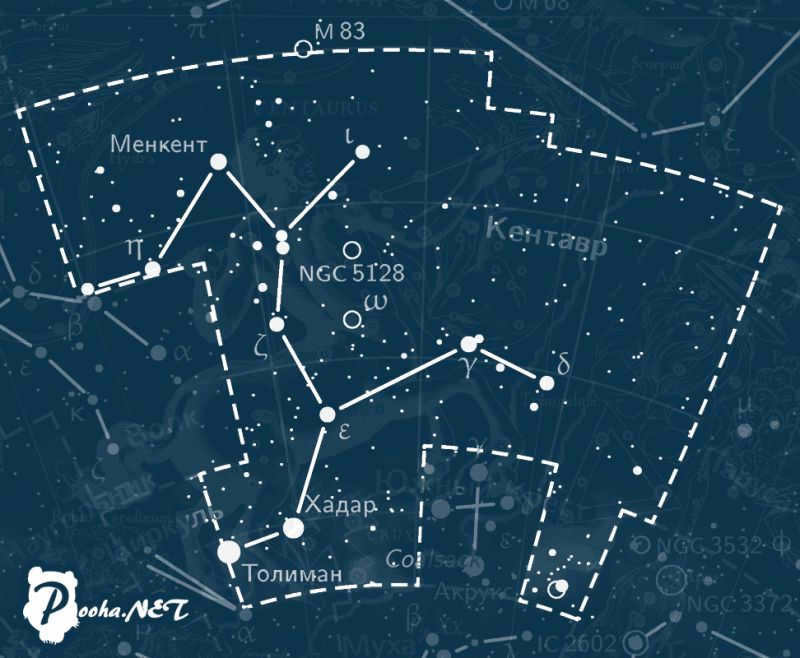
- Area: 1,060.422 square yards.
- Occupies a small portion of the total area: 2.57 percent.
- Abbreviation: CEN
According to Greek mythology, the constellation represents the centaur Chiron, who ascended to the heavens. Chiron, the son of Cronus and the nymph Phyllira, was known for his wisdom in both science and art. He served as a tutor to Greek heroes such as Achilles, Jason, and the god Asclepius. However, there is another mythological centaur, Pholus, who is also considered a possible inspiration for this constellation. Pholus met his demise when he was accidentally shot by Hercules with a poisoned arrow during Hercules’ fifth labor.
Alpha Centauri, the most brilliant star in the constellation, is also one of the most luminous stars in the night sky. Along with its contemporary moniker, it boasts several other names: Toliman, Bungula, and Rigel Centaurus (“centaur’s foot”). The latter designation was officially bestowed upon the star on November 24, 2016 by the International Astronomical Union (IAU). In addition to its luminosity, this star is visually a triple system. Its three constituent stars hold the top three positions on the roster of closest stars to the Sun. The two brightest components can be seen as a single star with the naked eye. The primary star bears a striking resemblance to the Sun in terms of mass and spectrum.
The ω Centauri (NGC 5139) is the largest globular cluster in our Galaxy and can be seen in this constellation. It is made up of numerous stars, including 165 pulsating variables with periods of approximately half a day. Despite being located 17,000 sv years away, it is the most luminous object in the sky. Additionally, it is the home of the Boomerang Nebula, which is known as the coldest place in the Universe. In Centauri, you can also find the NGC 5128, an unusual elliptical galaxy that has a wispy dark dust streak caused by a collision with a spiral galaxy.
8 Dragon
The 8 Dragon
The legendary creature, the 8 Dragon
Discover the power of the 8 Dragon
Unleash the might of the 8 Dragon
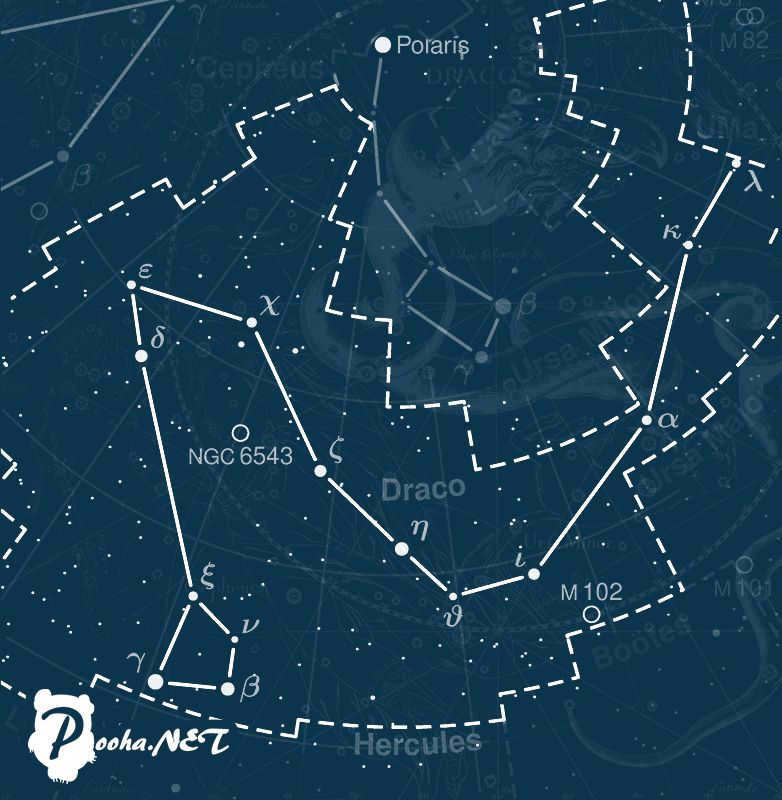
- Size: 1,082.952 square yards
- Accounts for a small portion of the overall space: 2.63 %
- Short form: DRA
There are various legends that explain the origin of this constellation in the celestial sphere. One of these stories revolves around Hercules’ final and most challenging task, in which he was required to retrieve three golden apples from the enchanting garden of the Hesperides for King Eurystheus. As Hercules approached the tree bearing the radiant golden apples, a ferocious dragon emerged and launched an attack. However, Hercules, being a courageous hero, fearlessly confronted the serpent and vanquished it with powerful strikes from his staff. He then successfully obtained the precious fruits and presented them to the king. In recognition of his bravery, the goddess Hera immortalized the dragon by transforming it into a constellation. Positioned at Hercules’ feet, the Dragon holds a significant place in the sky as a symbolic reminder of this remarkable feat.
The north pole of the ecliptic is located in this constellation, and its star Tuban (also known as α of the Dragon) was the closest star to the north pole of the world between 3700 and 1500 B.C. and will be again in 21,000 A.D. Despite its title, α of the Dragon is not the most luminous star in the constellation. The brightest star in the Dragon is Etamine (γ of the Dragon). Aside from its brightness, it is also remarkable for the observation that led English astronomer James Bradley to the discovery of the phenomenon of aberration of light in 1725.
7 Pegasus
Rephrase the text, making it unique, using English language and keeping HTML markup:
7 Pegasus
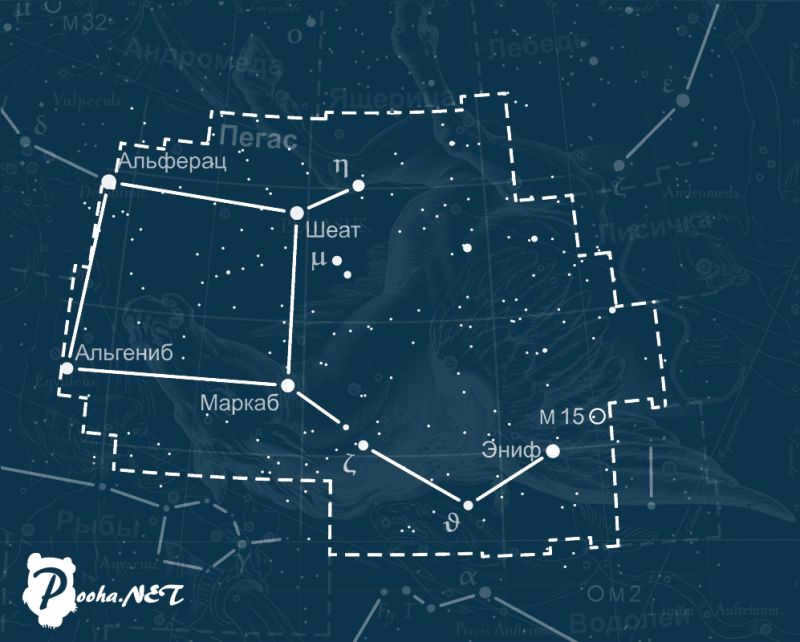
- Size: 1120.794 square yards.
- Occupies a small portion of the overall space: 2.72 percent
- Abbreviation: PEG
Pegasus, the legendary winged horse of Greek mythology, has multiple origin stories. One account states that he was the offspring of Poseidon and the gorgon Medusa. When Perseus beheaded Medusa, Pegasus and his brother, the warrior Chrysaorus, sprang forth from her severed body. Another version claims that Pegasus was created from the blood of Medusa, which dripped onto the earth. Because he was born near the Ocean, the horse was named Pegasus, which means “turbulent current” in Greek. Regardless of his origin, Pegasus possessed incredible abilities. He soared through the skies, resided in Corinth, dwelled in the mountains, and had the power to shape the landscape by halting the growth of mountains and creating springs with a powerful hoof strike. Eratosthenes, however, disputed the constellation Pegasus’s association with the winged horse, arguing that the constellation was wingless, unlike Pegasus. Despite this discrepancy, Pegasus continues to be known as Pegasus.
Throughout history, various cultures have associated this constellation with a common horse. For instance, the Babylonians referred to it as the “Horse,” while the ancient Greeks not only called it Pegasus but also the “Big Horse.” Even today, the Arabs still refer to this constellation as the Big Horse – Al-faras Al-azam.
The most luminous stars of Pegasus have rather straightforward Arabic names: Markab – meaning “Saddle” or “Carriage”, Sheat – meaning “Shoulder”, Algenib – meaning “Horse’s navel”, Enif – meaning “Nose”. There are several noteworthy entities in the constellation, among other fascinating ones. For instance, NGC 7331, the well-known Seyfert spiral galaxy, whose depiction is often employed to provide an impression of the appearance of our own Milky Way, and 51 Peg, the initial star similar to our Sun to possess an exoplanet, can be found here. It is also the abode of the Stephan Quintet, a collection of five interacting galaxies. Additionally, Pegasus lacks a star labeled with the letter δ. This is because Alpheratz, which lies on the border between Pegasus and Andromeda, was ultimately allocated to Andromeda in 1928.
6 Eridanus
- Area: 1137.919 square yards
- Represents: 2.76% of the total area
- Abbreviation: ERI
The constellation of Eridanus, also known as the River constellation or constellation-stream, is characterized by its long and winding shape. This unique form has led various cultures to associate it with rivers. In Greek mythology, Eridanus is often identified with different rivers, including the Euphrates, Po, and Nile. The main star of the constellation, Ahernar, has an Arabic name that translates to “end of the river.” Eridanus features prominently in several ancient Greek myths. For instance, it is said that Hercules learned from nymphs at Eridanus that only the sea god Nereus knows the way to the garden of the Hesperides, where a tree bearing golden apples resides and a Dragon awaits. Another myth commonly associated with Eridanus is that of Phaeton, the son of Helios. Phaeton was unable to control the celestial chariot of the Sun, resulting in catastrophic events. According to one version of the story, Zeus struck Phaeton with lightning and cast him into the river Eridanus. Alternatively, the constellation is said to depict the winding path of the chariot.
One of the fascinating celestial objects in this constellation is the star ε Eridanus. It bears resemblance to our Sun and is one of the nearest stars to it, positioned at a distance of 10.7 light years. Furthermore, in late 2009, the existence of one planet in its system was confirmed, with evidence of another.
Another well-known star is the bright star Ahernar, a blue supergiant belonging to the spectral class B3 Vpe. It is situated in the southern part of the constellation. This star is remarkable for its lack of perfect spherical shape – it spins so rapidly that its equatorial radius exceeds the polar radius by more than 1.5 times.
5 Hercules
The Five Labors of Hercules
Hercules, the legendary Greek hero, is known for his incredible strength and bravery. Throughout his life, he was tasked with completing a series of labors, each more challenging than the last. Here are the five labors of Hercules:
- The Nemean Lion: Hercules was tasked with killing the ferocious Nemean lion, whose hide was impenetrable to weapons. Using his bare hands, he strangled the lion and skinned it using its own claws.
- The Lernaean Hydra: Hercules had to defeat the nine-headed Hydra, a serpent-like monster that grew two heads for every one cut off. With the help of his nephew Iolaus, Hercules managed to burn the stumps of the severed heads to prevent them from growing back.
- The Ceryneian Hind: Hercules was sent to capture the sacred hind of Artemis, a deer with golden antlers that could outrun an arrow. After a year-long chase, Hercules managed to capture the hind without harming it.
- The Erymanthian Boar: Hercules was tasked with capturing a wild boar that was terrorizing the region of Erymanthus. After a fierce battle, Hercules managed to subdue the boar and bring it back alive.
- The Augean Stables: Hercules had to clean the vast stables of King Augeas, which had not been cleaned for years. Using his strength and wit, Hercules diverted two rivers to wash away the filth in a single day.
These labors were just a few of the many challenges Hercules faced throughout his life. They showcased his incredible strength, courage, and determination, and solidified his place as one of the greatest heroes of Greek mythology.
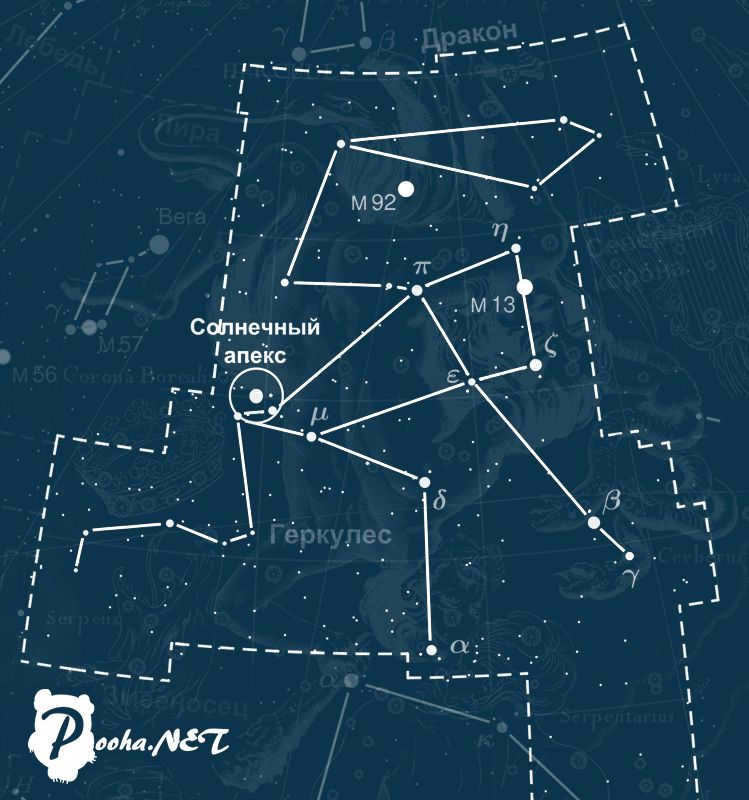
- Size: 1,225.148 square yards
- Accounts for a small portion of the overall space: 2.97%
- Short form: HER
We have encountered this hero previously and are already familiar with the constellation that lies at his feet. It would seem that everything about this constellation should be straightforward, but there is an interesting fact that originally the constellation was not personified and was referred to as “Kneeling”. In Claudius Ptolemy’s Almagest catalogue of the celestial sky, it is included under this name. Even Aratus in his “Apparitions” (3rd century B.C.) still states: “The representation of a man near them, exhausted by intense suffering. The name is unknown to us, as is the cause of his grievous suffering”. However, since the 5th century BC, the Greeks began calling the constellation “Heracles”. Well, Hercules (Latinized Hercules), let us remind you, is one of the main heroes of Greek mythology, the son of Alkmena and Zeus, renowned for his twelve labors, in the twelfth of which, according to one of the myths, he aided in sending the Dragon to the heavens.
The solar apex is situated within this constellation, which is essentially the point where we travel alongside the Sun in relation to other stars at a velocity of 20 km/sec. It’s worth noting that the Sun also moves with these stars around the galaxy’s center at a speed of 220 km/s.
Keith number 4
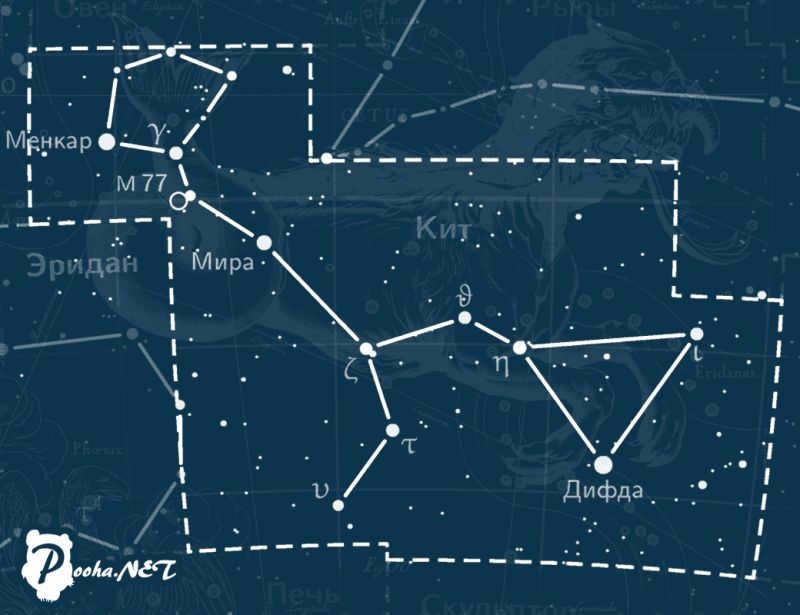
- Region: 1231.411 square yards
- Accounts for: 2.99% of the total area
- Short form: CET
The whale can be found near Aquarius and Eridanus, maintaining the aquatic theme in this portion of the celestial sphere. From a mythological perspective, it is often regarded as the creature sent by Poseidon at the request of the injured Nereids to threaten the people of Cepheus, the king of Ethiopia, with destruction. According to the myth, the Nereids were wounded due to the immodest prank of Cepheus’ wife, Cassiopeia – she had boasted that she was more beautiful than them. Consequently, all the problems that arose fell on the shoulders of Cepheus and his loyal subjects. Besides his wife, the king had an oracle and a daughter. The oracle declared that the anger of the deity could only be appeased if Cepheus sacrificed his daughter, Andromeda, to the creature. Upon learning this, the people of the land compelled their king to make this sacrifice. And so, Andromeda was left chained to a cliff, at the mercy of the beast. However, Perseus happened to see her, more beautiful than ever, and completely enchanted, he vowed to slay the beast if Andromeda agreed to marry him as a result of his heroic deed. After all the formalities were settled, the hero embarked on his battle against the creature. Once again, he showcased his skill and defeated the monster by using the face of the Gorgon Medusa, which turned anyone who saw it into stone. However, there is another version of the story, which states that Perseus killed the creature with the sword of Hermes, severing its head along with that of Medusa.
The variable star Myrida (ο Kita) in the constellation of Kita is responsible for the creation of a whole class of stars called “myrids”. It is called a variable star because it changes its brilliance from 2.0m to 10.1m during its period of 331.65 days, making it the brightest star in the constellation at some points and invisible even through binoculars at others.
Another well-known star in the constellation of Kita is τ Kita, which is the 17th closest star to the Earth. It shares similar characteristics with the Sun and has been referenced in numerous works of fiction, including the song “In the distant constellation of Tau Kita” by V.S. Vysotsky.
Three Ursa Major
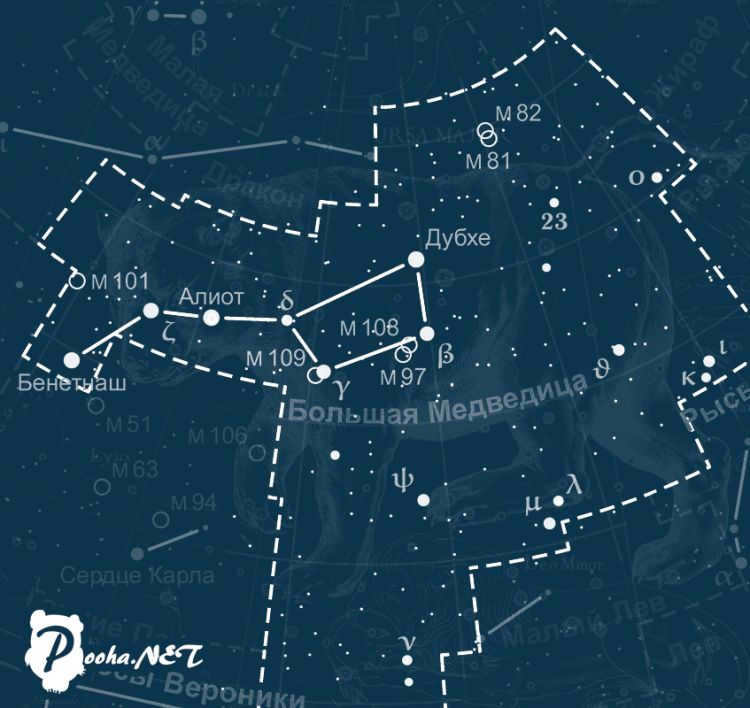
- Size: 1279,660 square yards
- Percentage of total area: 3.10%
- Abbreviated as: UMA
The famous constellation in the northern hemisphere, known as the Big Dipper, is the third largest constellation in terms of the area it occupies on the celestial sphere. The constellation is made up of the seven brightest stars, which form the well-known Big Dipper shape. Due to its visibility, this group of stars has been recognized by many different cultures throughout ancient times, each giving it their own unique name such as the Bucket, the Plow, the Elk, the Wagon, the Seven Wise Men, Rakovia, and more. There is even an alternative interpretation of the constellation, referred to as “The hearse and the Mourners”. In this interpretation, the stars are seen as a funeral procession, with mourners leading the way, followed by funeral stretchers. This is why the star η of the Big Dipper is known as the “leader of the mourners”.
The 5 inner stars of the Big Dipper (excluding α and η) are part of a single moving cluster in space. This cluster moves rapidly across the sky. Dubhe, the star closest to Polaris, and Benetnash, the last star in the handle of the Big Dipper, move in the opposite direction, causing the shape of the Big Dipper to change significantly over a period of approximately 100,000 years. Merak and Dubhe, the stars that form the far end of the Big Dipper, are known as Pointers because a straight line drawn through them points towards Polaris.
The Bucket offers another interesting feature. In close proximity to Mitsar, one can spot the 4 magnitude star Alcor (80 of the Big Dipper), which translates to “forgotten” or “insignificant” in Arabic. According to ancient beliefs, being able to differentiate Alcor is considered a test of visual acuity. The two stars, Mizar and Alcor, are commonly known as the “Horse and Rider”.
The Greek myths provide various explanations for the appearance of the notable group of stars in the sky. According to these myths, Zeus transformed the beautiful Callisto into a bear to protect her from Hera’s wrath. Another version, as told by Philemon of Syracuse, states that Zeus transformed two Cretan nymphs into bears and placed them in the sky as the Big and Little Bears. The first myth also explains the origins of the constellations Volopassus, the Little Bear, and the Hounds. In the kingdom of Arcadia, King Lycaon had a daughter named Callisto who was admired by Zeus. Zeus secretly visited Callisto in Lycaon’s palace, resulting in the birth of their son Arkad, who grew up to be a skilled hunter. When Hera discovered Zeus’s affair, she turned Callisto into a bear out of anger. Upon returning from a hunt, Arkad discovered a bear cub in his house and prepared to shoot it with his bow. However, Zeus intervened and transformed both Arkad and Callisto into constellations, saving them from death. Callisto became the Great Bear, while her favorite maid was transformed into the Little Bear. Additionally, Arkad became the constellation Volopas, guarding his mother and protecting her from the Hound Dogs.
Virgo 2
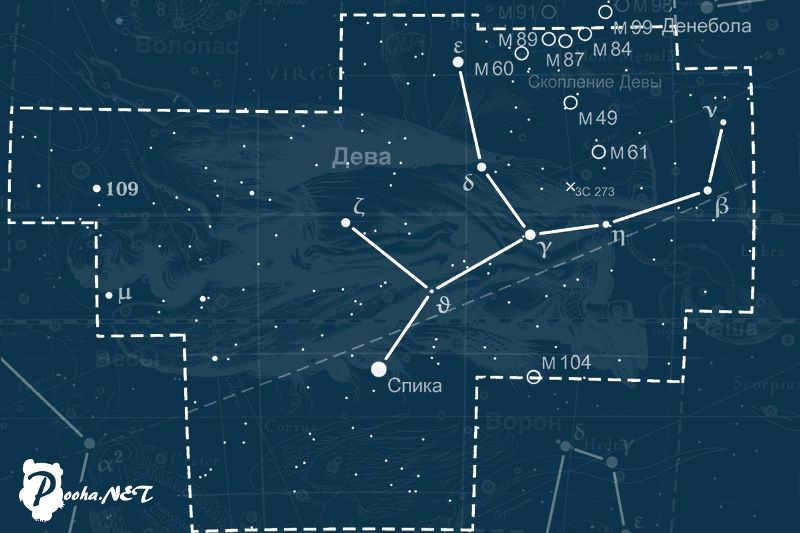
- Region: 1294.428 square yards
- Constitutes of the entire region: 3.14 percent
- Short form: VIR
Virgo is the astrological sign that marks the position of the fall equinox. It is one of the largest constellations in terms of area, and in ancient Greek mythology, it was associated with various goddesses and heroines. The most commonly known representation is that of Demeter, the goddess of fertility and agriculture, who was the daughter of Cronus and Rhea and the mother of Persephone. However, there is also a tragic myth related to Dionysus, a god who brought gifts with unforeseen consequences. According to this myth, three distant constellations appeared in the sky: Virgo, Volopassus, and the Big Dog. This is just one of the many versions of the myth surrounding the origin of Volopassus.
This tale recounts the era when humanity was first uncovering the process of producing alcoholic beverages and exploring their consumption. During this distant time, the deity Dionysus traversed the world with great vigor, bestowing upon people the secrets of winemaking, desiring their happiness and revelry. Some individuals warmly and joyfully embraced his selfless acts, while others reacted quite differently. Those who embraced his generosity were richly rewarded, while those who did not fell out of favor with both Dionysus and Zeus, facing severe punishments from the divine duo. One such individual who fell into the former category was a man named Icarius. Icarius proved to be a diligent student and successfully replicated the extraordinary wine recipe gifted to him directly by Dionysus. In the evenings, Icarius, a generous soul, shared the wild libation with his shepherds, who returned from a challenging day’s work in the fields. The shepherds, being simple folk, interpreted the effects of the wine on their minds (which they had previously been unaware of) as an attempt by Icarius to poison them. Consequently, under the influence of alcoholic intoxication, they tragically killed their master and decided to conceal his body deep within a crevice in the towering mountains. Thus, Icarius’ tale came to an abrupt and tragic end.
Icarius had a daughter named Erigona. After her father disappeared, Erigona tirelessly searched for him, but her efforts were in vain. Despite feeling hopeless, she decided to embark on a search with her loyal dog, Myra, who led her towards the towering mountains. Following the trail, Erigona and Myra arrived at a deep crevice where they discovered her deceased father. Overwhelmed by grief, Erigona later chose to end her own life by hanging herself from a tree near his grave.
It is during this somber and tragic moment in history that the god Dionysus reappears and transforms Icarius, Erigone, and her faithful canine companion, Myra, into constellations that are now known as the Magpie, Virgo, and Big Dog.
Shifting our focus from the melancholic depths of mythology to the enigmatic depths of outer space, it is worth noting that the upper right area of the Virgo constellation holds a significant fascination for experts in the field of extragalactic astronomy. The reason being that within this relatively compact portion of the celestial sphere, there are a minimum of two and a half thousand remote galaxies. This expansive expanse, adorned with stellar systems, stretches beyond the boundaries of Virgo and extends into the domain of the constellation Veronica’s Hair (which was formerly considered a part of Virgo). The sheer magnitude of this galactic cluster is such that it takes a staggering 1.3 billion years for its light to reach our planet. By observing this particular sector of the heavens, we are afforded a glimpse into the remote history of the universe.
The Virgo cluster of galaxies, which is located approximately 59 million light-years away, is home to over 1,500 members. Additionally, within the constellation Virgo, you can find notable celestial objects such as the Sombrero Galaxy (M 104) and the brightest quasar known as 3C 273. Interestingly, 3C 273 is also the most remote object that can be observed using an amateur telescope.
1 Hydra
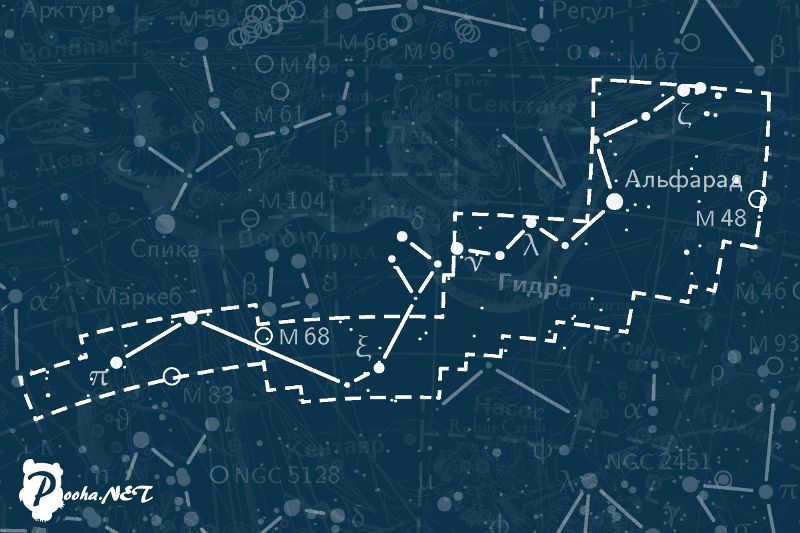
- Measurement: 1302.844 square yards
- Represents a portion of the entire space: 3.16 percent
- Shortened Form: HYA
The constellation Hydra holds the distinction of being the largest constellation in terms of its occupied area in the night sky. Situated in the southern hemisphere, Hydra shares its celestial neighborhood with the equatorial constellation Virgo. In ancient Greek mythology, the image of the Lernaean Hydra, a creature vanquished by Hercules during his second labor, was associated with this constellation. According to the legends, King Eurystheus did not acknowledge this achievement, as Hercules received assistance from his companion Iolaus, who cauterized the Hydra’s severed heads. Nevertheless, this did not dissuade Zeus, the mighty god of thunder and Hercules’ father, from immortalizing the Hydra in the heavens as a constellation, in recognition of his son’s remarkable and courageous feat.
Located in the western region of the constellation, one can easily spot a polygon with an irregular shape. This particular group of stars is commonly referred to as the Hydra’s Head. It consists of five stars – ζ, ε, δ, σ, and η of Hydra. The asterism is known as the Pearl Necklace in Arabic and the Scarlet Bird in Chinese. Furthermore, within this constellation, stargazers can take delight in observing a planetary nebula named Jupiter’s Ghost through a telescope.
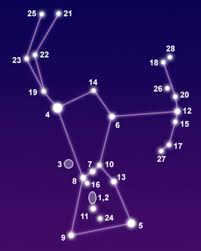
Scientific reports
This article will provide you with information about the Orion constellation, which is situated on the celestial equator.
The Orion constellation: a fascinating story
The Orion constellation is one of the most prominent and well-known constellations on the celestial equator. Throughout history, it has been referred to as “The Hunter.” It is often depicted as a hunter chasing a Hare with two dogs or standing in front of Taurus.
Within the constellation, you will find the two brightest stars Betelgeuse and Rigel, as well as the Orion Nebula, the Horsehead Nebula, the Trapezium Cluster, and Orion’s Belt.
Myth of the constellation Orion
Orion, born to Euryala, the daughter of Minos and Poseidon, the god of the oceans, was a skilled hunter. The Odyssey, an ancient Greek epic poem by Homer, portrays him as an invincible and towering figure. In one version of the myth, the son of Poseidon becomes infatuated with the seven sisters of Pleione and Atlas and embarks on a pursuit. To protect the sisters, Zeus conceals them within the Taurus constellation in the night sky. To this day, it appears that Orion continues his quest to find the elusive sisters.
According to a different tale, it is said that Orion became infatuated with Merope, the daughter of the king of Enopolis. However, she did not share the same feelings for him. One day, in a state of drunkenness, the hunter began to harass Merope against her will. In response, King Enopolus blinded Orion and banished him from his kingdom. Fortunately, the blind man received compassion from the god Hephaestus, who instructed his assistant to restore Orion’s sight. With his vision restored, Orion then ascended to the heavens.
There is another myth associated with Orion. Once, the boastful hunter claimed to Artemis that he could kill any creature on Earth. In response, the goddess sent a scorpion to confront him, which ultimately ended up killing him with its lethal poison. Both Orion and the scorpion were immortalized in the night sky. In the western horizon, Orion appears to be fleeing from the scorpion.
The main stars in the Oreon constellation:
- Rigel. This is a faint and irregularly variable blue supergiant.
- Rigel A. It is a double spectroscopic star that will eventually transform into a red supergiant.
- Betelgeuse. It is a variable and semi-regular red supergiant and also the brightest star in the Orion constellation. In the future, it will undergo a supernova explosion that will make it visible even during the day. The glow of this supernova will surpass even the moon, making it the most brilliant supernova ever observed.
- The "Star of the Amazon," known as Bellatrix, is another name for the stars in the constellation of Orion. It is a giant star that shines with a luminous, hot blue-white light. Bellatrix is the hottest star that can be seen without a telescope. After a couple of million years, it will change into an orange giant and eventually become a massive white dwarf.
- Mintaka is a binary eclipsing variable star in the constellation of Orion. It will eventually end its life in a powerful explosion and supernova. Among the stars in Orion, Mintaka is the least bright.
- Alnilam is a supergiant star that shines brightly in a blue color. It is located at the very center of the Orion constellation. Currently, the star is losing mass, which means that Alnilam will soon transform into a red supergiant.
- Alnitak is a system that consists of multiple stars. It is situated on the eastern side of the Orion constellation.





